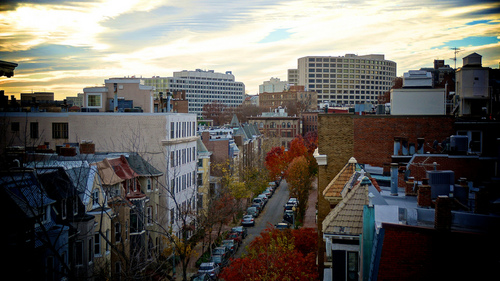Rent in our region is expensive. Does that mean it’s unaffordable?
It’s no secret that rent prices in the Washington region are very high. But when we talk about affordable places to live, we often forget that there are two components to affordability: there’s how much we spend on rent, but also how much we earn in income.
Typical surveys like this one by Zumper usually find that a select group of cities like New York, San Francisco, and Washington have the most expensive apartment prices. According to these measurements, Washington has the fourth-most expensive rent of any large city in the country.
But if rent is $1000 in two different cities, but the average income in City A is 50% higher than in City B, then residents of City A can afford housing more easily, generally speaking. A recent article by Greater Greater Washington contributor Kate Rabinowitz demonstrated how cheaper cities also often lack good-paying jobs.
Here’s how various metro areas stack up
To better evaluate this relationship, I looked at households across major metropolitan areas and how much of their income they spend on rent.
Two terms that are critical to understand renting affordability are rent-burdened households (those than spend over 30% of income on rent) and severely rent-burdened households (those that spend over 50% of their income on rent). For my own analysis, I chose only to look at rent-burdened households.
I also did not include median income in this analysis, as large cities in the United States have a large amount of income inequality, so median income does not necessarily reflect the experience of low-income households.
Additionally, I chose to use Census’s Metropolitan Statistical Areas (MSAs) for data samples, rather than just large cities proper since most Americans live outside of major cities. Here are the 33 metropolitan areas with a population of above two million:
The results are very different from what we might expect. Cities typically associated with high rent, such as Washington (7th place), Seattle (10th place), Boston (12th place), and San Francisco (16th) have below-average numbers of rent-burdened households. Rent burdens in Texan cities are among the lowest, while the places where the most people use more than 30% of their income to cover rent are in California and Florida.
For reference, although many cities have significantly lower rent burdens than the US average, over half of renting US households spend above 30% of income on rent. Consequently, over 45% of renting households are rent-burdened in even the most affordable cities.
At the other end of the spectrum, over 60% of households are rent-burdened in the most unaffordable metropolitan areas, such as Miami and Riverside.
Although these measurements help better explain housing affordability, there are a few things that this analysis does not take into consideration.
- This analysis only looks at renting households. Some metropolitan areas may have a larger share of owned households, which are difficult to compare to renting households.
- The data measure the total number of rent-burdened households; they say nothing about households that are severely rent-burdened. That is to say that these measurements tell us about the breadth of the problem, not the depth.
- This analysis does not evaluate apartment size or household occupancy. Accordingly, residents of cities with expensive rent may make the “economic choice” to live in single apartments with a high number of occupants (roommates, multi-generational households, etc.).
- The Census’s measure of rent-burden does describe how housing subsidies, rent control, and other mechanisms affect households’ ability to afford rent. In all likelihood, liberal housing policies in cities like New York, Washington, and San Francisco decrease the number of households that are rent-burdened.
Washington DC’s relatively high incomes may make it more affordable in comparison to economically depressed cities. This does not mean, however, that all households in the region have equal opportunities to find affordable housing, especially those below the median income.
As income influences affordability, higher salaries should be part of the larger debate of housing affordability in the region and across the country — especially since incomes have stagnated for most workers, while the price of housing continues to rise.


